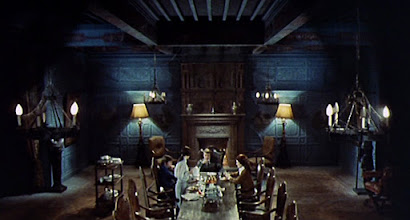The Legend of Hell House is a 1973 British horror flick with a screenplay by Richard Matheson, based on his novel Hell House.
This is a ghost story but it belongs to the interesting sub-genre of ghost-hunter movies, in which a team of occult investigators attempts to prove or disprove the existence of a ghost. In this case it’s the ghost reputed to haunt Belasco House in England. The famous, or infamous, Hell House.
The investigative team in this case is a mix of scientists and non-scientists. There’s physicist Dr Lionel Barrett (Clive Revill) whose approach is clearly going to be rigorously scientific. He has various electronic devices with which he believes he can detect ghosts, if they exist. The second member of the team is mental medium Florence Tanner (Pamela Franklin), very young but reputed to be the best in her field (just as Dr Barrett is considered the best in his field). The final team member is physical medium Ben Fischer (Roddy McDowall), the only survivor of the previous investigation into this notorious haunted house. Also tagging along, perhaps unwisely, is Dr Barrett’s wife Ann (Gayle Hunnicut).
The house was supposedly the site of some gruesome crimes committed by its original insane millionaire owner, Emeric Belasco, and the ghostly presences (for there are likely more than one) are assumed to be the tortured spirits of Belasco’s victims.
There have in fact been two previous attempts to investigate the ghost, or ghosts, of Belasco House. Eight people died, or were sent permanently insane, in those attempts.
The house is forbidding enough. Belasco had all the windows bricked up, for motives that are obscure but undoubtedly sinister. Even Dr Barrett seems ill at ease. Florence Tanner seems on the verge of freaking out right from the start. Ben Fischer is tightly controlled, but clearly he is an emotional cauldron beneath the surface. Dr Barrett is confident and assured.
When strange things start to happen, things that certainly look like supernatural manifestations, you might imagine that Dr Barrett would be shocked or disappointed. In fact he is pleased. This is exactly what he expected. Why he expected this is something we will find out later.
Whatever is happening it seems that Miss Tanner is either the cause, or the victim, or the conduit.
There’s no sex and only very brief nudity in this movie but there’s no shortage of erotic subtexts. The terrible events that happened all those years before, the events that began the haunting of Belasco House, were all connected with sex. Sexual excesses of many different varieties, none of them wholesome. The two women, Ann Barrett and Florence Tanner, seem to be possessed by destructive sexual energies over which they have no control and which they cannot comprehend.
There is one memorable scene in which the house (or one of the spirits) appears to take possession of Miss Tanner that plays as a kind of psychic rape scene. In fact the house seems to be trying to seduce, or rape, both the women.
There’s a fascinating power struggle between two competing views on the nature of Hell House. Dr Barrett believes there really is a force haunting the house but he sees it as being purely natural - an accumulation of physical energy. This can be dealt with by purely physical means. Miss Tanner holds to the supernatural view, that the house is haunted by actual spirits of the dead. Both Dr Barrett and Miss Tanner are grimly determined that their own view should prevail.
The special effects are simple but effective. This is not a horror movie in which there is any need for fancy special effects to create monsters. The evil is all unseen evil. This is a movie that relies on suggestion and on atmosphere.
Director John Hough throws in a few camera tricks but he uses them sparingly and only when they actually contribute something.
Richard Matheson was one of the major 20th century science fiction writers whose work often combined science fictional and horror themes (including his classic and oft-filmed I Am Legend). He was also of course a famed television writer, being responsible for some of the most memorable episodes of the original Twilight Zone series.
The cast is a collection not of big names but of underrated talents. Pamela Franklin showed plenty of early promise but stardom eluded her. Roddy McDowall was certainly well known but never got quite the respect he deserved as an actor. Clive Revill is one of those faces that people recognise without being able to put a name to it. Gayle Hunnicut mostly worked in television. Rounding out the cast are a couple of notable supporting players - the wonderful Roland Culver as the elderly eccentric who finances the investigation and the always delightful Peter Bowles as his pompous lackey. So no really big stars but all solid actors who are well cast.
All the performances are excellent. Pamela Franklin gets the showiest part and she makes the most of it.
The 20th Century-Fox Region 4 DVD offers a good anamorphic transfer with no extras apart from a trailer. Given that most of the cast members are still alive it’s a great pity there’s no commentary track or cast interviews.
If Robert Wise’s 1963 version of The Haunting is the greatest haunted house movie of all time (and few would despite its claim to that title) The Legend of Hell House runs it a close second. A superb example of subtle intelligent horror. Very highly recommended.





1 comment:
Great review of a great film!
Post a Comment